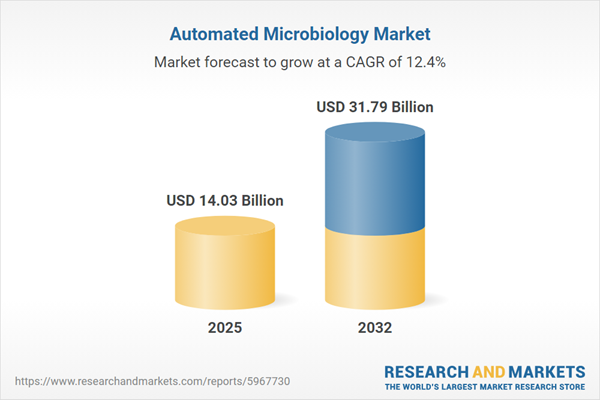Speak directly to the analyst to clarify any post sales queries you may have.
The automated microbiology market is entering a phase of accelerated adoption as enterprises seek to strengthen diagnostics, streamline laboratory operations, and build future-ready functions amid fast-evolving regulatory and technology landscapes. This page delivers focused market intelligence designed specifically for senior leaders shaping next-generation laboratory strategies.
Market Snapshot: Automated Microbiology Market Trends
In 2024, the automated microbiology market reached USD 12.51 billion, reflecting robust momentum with a compound annual growth rate (CAGR) of 12.36%. Key growth drivers include rapid integration of advanced robotics, artificial intelligence, and powerful analytics into daily laboratory processes. High-impact adoption is evident within healthcare, pharmaceutical manufacturing, food production, and environmental monitoring, where organizations leverage automation to address stricter compliance demands and streamlined operations. Investment in adaptable diagnostic systems and upgrades to digital infrastructure is becoming essential for organizations to remain compliant as regulation and market expectations continue to advance. In the context of increasing complexity, automation is emerging as a prerequisite for competitive and resilient laboratory operations.
Scope & Segmentation
- Technology Platforms: Range from traditional culture-based solutions such as automated colony counters and staining devices, to advanced modalities like flow cytometry, mass spectrometry, next-generation sequencing, PCR, and microarray technologies. Each solution supports accurate diagnostics and operational oversight.
- Product Categories: Include consumables, complete reagent lines, laboratory instruments, integrated and stand-alone software solutions, plus essential services such as validation and maintenance. Each category is instrumental in empowering continuous lab automation and reliability.
- Application Areas: Span academic research, clinical diagnostics for infectious diseases, oncology screening, pharmaceutical quality assurance, environmental surveillance, and food quality management. All require decisive compliance strategies and robust quality protocols.
- End Users: Comprise academic institutions, hospitals, clinical laboratories, pharmaceutical firms, and large enterprises in food and beverage. These organizations focus on elevating accuracy, shortening turnaround times, and upgrading processing capabilities.
- Automation Levels: Cover both fully and semi-automated platforms. Choices allow organizations to scale solutions according to their current infrastructure, budget limitations, and expansion plans.
- Regional Dynamics: Assess market conditions, compliance standards, and technology uptake across the Americas, Europe, Asia-Pacific, Middle East, and Africa. Understanding these regions supports development of tailored strategies for both local initiatives and broader international expansion.
- Profiled Companies: Include industry leaders such as bioMérieux SA, Becton Dickinson and Company, Thermo Fisher Scientific, Danaher Corporation, Siemens Healthineers AG, Merck KGaA, Sysmex Corporation, PerkinElmer, bio-Rad Laboratories, and Abbott Laboratories.
Key Takeaways for Decision-Makers
- Deploying intelligent automation and machine learning tools advances data security and supports comprehensive diagnostic management across distributed laboratory networks.
- Incorporating robotics and miniaturized systems relieves human resource constraints and enables high-quality laboratory performance, supporting agility regardless of fluctuating staff availability.
- Building scalable automation frameworks enables organizations to implement or expand capacity at a measured pace, maintaining compliance and supporting future growth with flexible system upgrades.
- Strengthening digital infrastructure and establishing supplier alliances increases supply chain reliability, lowering risk in dynamic regulatory environments and enabling timely response to disruptions.
- Consistent investment in digital skill development ensures effective adoption, driving operational gains and maximizing long-term return from automation technologies.
- Adapting automation strategies to local and evolving compliance mandates protects organizations from regulatory pitfalls, sustaining secure and consistent laboratory processes worldwide.
Tariff Impact: Adjusting to 2025 Supply Chain Challenges
With forthcoming adjustments to US tariff policies, many organizations are proactively diversifying supplier relationships and considering domestic or nearshore manufacturing models. These steps are intended to maintain operational consistency and safeguard market share, while mitigating risk driven by shifting logistics and regulatory landscapes.
Automated Microbiology Market: Methodology & Data Sources
This analysis combines direct executive interviews, rigorous technical evaluations of laboratory automation systems, and comprehensive regulatory reviews. Supplementary inputs are drawn from peer-reviewed literature, patent research, and extensive market data from leading industry sources, providing reliable guidance for strategic planning.
Why This Report Matters
- Equips business leaders with actionable strategies to integrate automation, optimize compliance, and confidently navigate risk by aligning laboratory operations to evolving market and policy requirements.
- Presents clear segmentation and in-depth regional market perspectives, enabling investment decisions founded on precise risk assessments and emerging opportunities.
- Addresses pressing regulatory and supply chain topics, offering structured guidance for achieving stable and adaptive laboratory operations in changing industry environments.
Conclusion
Organizations leveraging automated microbiology solutions are building operational agility and quality through advanced digital expertise and robust supplier partnerships. Sustained adaptability and ongoing innovation remain essential for market leadership in this evolving field.
Additional Product Information:
- Purchase of this report includes 1 year online access with quarterly updates.
- This report can be updated on request. Please contact our Customer Experience team using the Ask a Question widget on our website.
Table of Contents
3. Executive Summary
4. Market Overview
7. Cumulative Impact of Artificial Intelligence 2025
Companies Mentioned
The companies profiled in this Automated Microbiology market report include:- bioMérieux SA
- Becton, Dickinson and Company
- Thermo Fisher Scientific Inc.
- Danaher Corporation
- Siemens Healthineers AG
- Merck KGaA
- Sysmex Corporation
- PerkinElmer, Inc.
- bio-Rad Laboratories, Inc.
- Abbott Laboratories
Table Information
| Report Attribute | Details |
|---|---|
| No. of Pages | 189 |
| Published | November 2025 |
| Forecast Period | 2025 - 2032 |
| Estimated Market Value ( USD | $ 14.03 Billion |
| Forecasted Market Value ( USD | $ 31.79 Billion |
| Compound Annual Growth Rate | 12.3% |
| Regions Covered | Global |
| No. of Companies Mentioned | 11 |









